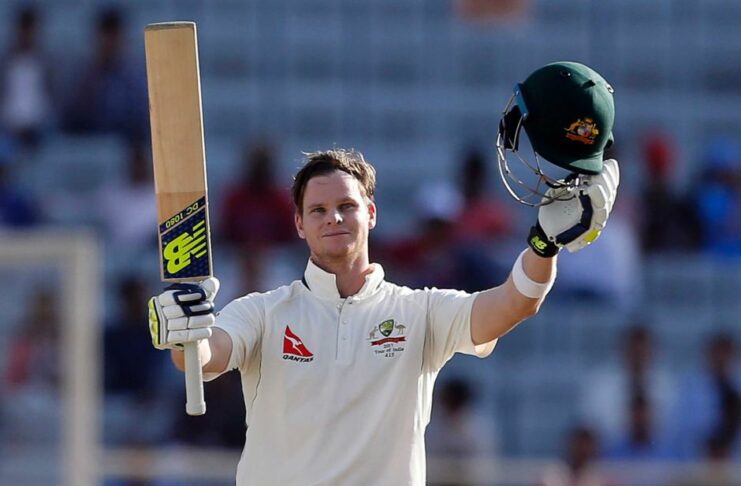As dramatic as it may sound, today Steve Smith is more than a name. His name brings up multiple reactions from the cricketing fraternity. To his opponents- whom he’s blasted away on the way to hundreds and sparkling feats with the bat, he’s difficult to dislodge. To some, he’s ‘right up there’ with the greats. To others, he’s got a lot to learn.
To his contemporaries who wear an Australian jersey, he signals hope of a comeback.
But to Australian fans, Steve Smith exists in multiples
He’s been their best batsman of the modern age as also an evil incarnate. The same fans who roared loudly, celebrating a sparkling century with the same fervour as the man responsible for them feel he has backstabbed them. How swiftly do tides change in sports, don’t they?
Before March 22, 2018- Steve Smith was Australia’s answer to Virat Kohli. Post that, he’s become a poster-boy of “things not right in the sport.”
Classicists for whom Australian cricket- nevermind the ugly ball-tampering saga- is a bastion of absolute excellence and every competition a continuance of the great legacy of Sir Don Bradman feel Steve Smith was responsible for corrupting the spirit of the game.
Can you dare doubt them?
Can Steve Smith look them in the eye?
But such is life. That is what you call cricket. And precisely, that is where Steve Smith, who was last seen on a cricket pitch on March 22 has his task cut out.
The journey from playing cricket in Sydney’s grassy parks and pulsating grounds to striking ecstatic worldwide hundreds might have been an onerous and thrilling one. Even grander may have been the feeling of representing a status quo; the tag of world’s best batsmen.
But knowing Smith and his feel for a contest, he will identify a thrill in mounting that great comeback.
While the site of Smith watching the game from sidelines may muster a laugh for his haters, it stomachs a great anticipation of sorts.
It will actually signal a doomsday if a better and more alert Steve Smith returns to scoring ways. But, for Australia- whose best batsmen on the current make up are Shaun Marsh and Glenn Maxwell- it will be like seeing a batting great reinstated.
On first thoughts, Steve Smith may not seem that great a figure, the numbers backing him amplify his standing in the sport.
Smith sits on a wealth of numbers
As you traverse an endlessly arresting array of Smith’s stats, each number carries weight and surreal impact. 8 of his 24 Test hundreds have come against Australia’s fiercest rivals- England, whom he has pounded most of the time, including a belligerent 239, his greatest knock to this day.
His batting average against India, the home of Smith’s greatest batting contemporary, is 84. The least impressive average he has against noted teams is 41 against Sri Lanka and South Africa. This is when against Pakistan, England, and New Zealand, former Australian captain has constructed skyscrapers in form of batting average- 59, 56 and 68 respectively.
In these amazing feats lies the perplexity of one of modern cricket’s greatest batsmen, perhaps an able torch-bearer among Virat Kohli, Kane Williamson and Joe Root. How was the man so highly thought of responsible for plunging Australia to the annals of deep mediocrity and such unsportsmanlike conduct?
Maybe, at 29, Smith’s got spring in his bat and shall learn to keep his head dignifiedly inside the baggie-green. Maybe, he’s not the most complete cricketer as yet even as his batting feats warrant a comparison with the greats.
And maybe there ought to be a divine intervention in the future, an irony of which is immediately reflected with Smith sharing his birthday with Mark Waugh, arguably the greatest Australian since Sir Don Bradman.
When Steve Smith was appointed the captain of the Australian national team, in 2014, it seemed that it was almost a natural order of things. Like a true Hollywood blockbuster, whose franchises First, there was a Border. Then came Steven Waugh. Next was Ricky Ponting, followed by Michael Clarke. And finally, Steven Smith.
Has Smith been leading a side as richly talented as his former leaders?
The current make-up of Australia is of a side where many a newbie is still hunting for stability. D’Arcy Short and Travis Head aren’t the most experienced heads around, with the possible exception of Nathan Lyon.
But here is what’s telling.
A greatly underappreciated fact about Smith’s reign as Australian captain is the often disbanded and seemingly capricious unit he leads.
He’s yet to experience the best of Australian siblings- Mitchell and Shaun- two handy batsmen of the side. Would you consider them in the same league as the Waugh brothers?
In Mitchell Starc, Steve Smith may have one of the world’s quickest bowlers, but what we don’t seem to reflect well enough is how susceptible world’s best bowler is to injuries.
In Glenn Maxwell, he may boast of a smasher of the cricket ball. But what we don’t commonly reflect on is how dwarf and polarised do Maxwell’s on-field performance seem in front of the imagery of ‘Big Show’.
Smith was the key figure- producing both inspiring batting feats as well as the force injecting resilience- in a side that post-Shane Watson, Michael Clarke was undergoing a period of onerous transition.
His absence currently hurts big. Thankfully, his return is due in another 9 months from now.
Till then, die-hard fans will have to resort on famous batting templates decorated by a “Smithsonian” impact on Youtube. And probably, to contain the hurt, stem pleasantness from the site of the Ashes trophy that was earned at the back of Australia’s true 2017-hero.

